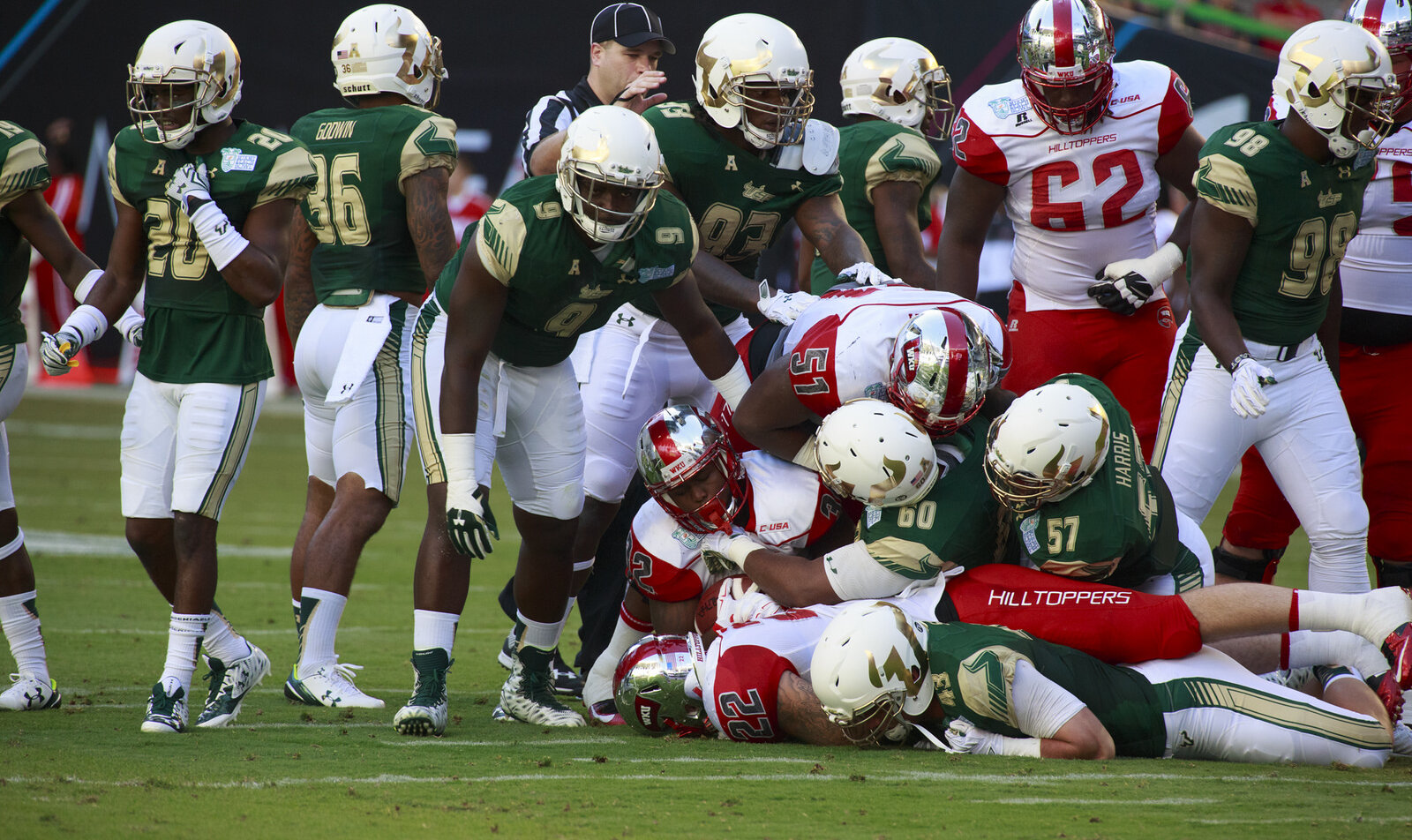The Group of Five Playoff: Could it Work?
By Eric Thompson in College Football
Updated: January 17, 2018 at 9:39 am ESTPublished:

Editor’s note: This is part two of a two-part series on the current College Football Playoff system and its inherent bias against non-power conference schools. A couple weeks ago, Eric looked at how the current CFP system is stacked against Group of Five schools and the odds of one ever making the current four-team playoff.
It’s been three months since Sean Frazier floated the idea of a Group of Five playoff: a postseason tournament for college football’s five ignored conferences. But oddly enough, some of the biggest opposition to the idea has come from members of said conferences. As AAC commissioner Mike Aresco said to anyone who would listen, “we compete for national championships like anyone else in FBS, including the Power Five, and have no interest in any kind of separate championship.”
Well, if he had read Part 1 of this series, Aresco would know that, no, you don’t compete for championships. Your conference isn’t even on the radar. Despite those adorable efforts to coin the term “Power Six,” the AAC isn’t going to get more than the chance at a New Year’s Six bowl berth. So maybe hear out Frazier and his Group of Five playoff idea.
The only benefit of staying the course with the current CFP is the revenue share these smaller schools receive. And while $83.5 million sounds nice (plus $4 million for whichever conference qualifies for the New Year’s Six bowl), that only amounts to about a 14-percent share of the total postseason revenue. Remember, that’s split between 60 schools. In other words, nearly half of the FBS gets one-seventh of the money.
Exploring this playoff option would be a worthwhile undertaking, not only for these smaller schools, but also for the CFP and its partners at ESPN. If there’s anything we’ve learned over the first three years of the CFP system, it’s that fans flock to games with greater stakes.
The three CFP games — the two semifinals and the national championship — have finished top three in bowl ratings each year by a wide margin, and the boon they’ve provided has helped hide the fact that almost every other bowl game is not doing well. Take this year’s insane Rose Bowl: on the field it was perhaps the best game since Vince Young’s Texas Longhorns beat USC on the final play. Yet, in terms of viewership, they weren’t even in the same stratosphere. The Trojans’ 52-49 win over Penn State was the second-lowest rated Rose Bowl ever!
The CFP games aren’t immune to the ratings dip: after exploding onto the scene in 2015 with 34.15 million viewers watching the championship game, this year’s title game rematch drew just 25.27 million. If the playoff games are going to be the main source of profits, it’s concerning when ESPN winds up paying $20 million in make-goods for grossly under-performing on New Year’s Eve games.
Stationary or slight declines in ratings aren’t great for the future of the playoff, but they paint a far more optimistic picture than attendance numbers. In 40 bowl games this year (not including the championship, which rotates stadiums), overall announced attendance was down five percent. On TV the real numbers looked even lower than that. (By the way, if you are reading this and were in attendance at the St. Petersburg Bowl, I have your sunglasses.)
On top of public disinterest in all of these lesser bowl games, there’s also a lack of commercial interest. Six games couldn’t even secure a title sponsor, while others are attached to companies so obscure or laughable, you’d think we’re back in the dot-com bubble.
All these bummer numbers illustrate that a Group of Five playoff would be in the best interest of a lot of factions. During that first few weeks of bowl season, instead of MAC and Conference USA matchups with no perceived meaning, why not draw more fans in with a few of Group of Five semi-final games? Like I said earlier: fans like stakes. This year, the FCS Championship game pulled in 1.562 million viewers (on ESPN2), outperforming eight different FBS bowls.

The reason the CFP exploded onto the scene was because it was a change from a tired system. If college football isn’t willing to keep changing, it’s not going to keep growing. And unfortunately, it doesn’t sound like many people inside the business are too keen on a playoff expansion: a CBS poll found that 60-percent of players were in favor of the current four-team playoff format. If the idea of not expanding has trickled all the way down to the players, then it’s pretty entrenched.
So if they won’t add four extra teams to the biggest dance, create another dance floor on the tier below. Frazier’s floating of the G5 playoff included scant details, but it’s easy to think of a workable system.
They could simply build this into the playoff system that’s already in place. Using the current rankings, you could select the top-four Group of Five teams at large and pit them against each other. That might require expanding the CFP rankings from 25 teams to 35, which the committee would probably hate, but screw those guys anyway.
Or, if conferences like the AAC still want to compete against the best, the one at-large bid for a New Year’s Bowl game could remain for the best ranked team in the Group of Five, and the four remaining conference champions could battle it out in the playoffs — adding an extra element of importance to each conference title game. (The Sun Belt currently doesn’t have a championship game, but in 2018 they’ll become the last conference to add one.)
As a part of the NCAA, they’d still be entitled to a share of the overall CFP revenue, but having their own tournament would give these conferences a chance to grow their slice of the pie, while hopefully getting their best athletes and coaches more exposure. It could also provide a few of the smaller bowl games a chance to thrive by rotating the location of the playoff games each year.
With so many of the necessary elements already in place, the costs of starting this Group of Five playoff would be minimal. The only barrier to this idea really taking off is the pride of programs like Navy, that don’t want to admit they’re less-than.
A criticism from dissenters is that a separate playoff would just emphasize the gap between the Power Five and the rest. But staying with the status quo and expecting that gaping canyon between the haves and have-nots to close may be the more foolish undertaking. College sports are going to be changing: soon, players will be paid, and then that gap between the two will only continue to grow.
So embrace change, Group of Five schools. Change is scary, but it also means an actual chance at making the playoffs, so how bad can it be?
Over/under on the year a Group of Five playoff is implemented: 2025
Inertia can be as big a hurdle as anything; 2025 marks the year when the CFP’s existing deal with ESPN is set to end.

Sports Writer
Eric Thompson has been with SBD since 2015, serving as a sports betting expert in NFL, NHL, NBA, and MLB. If you want someone who eats, sleeps, and breathes sports news and betting, Eric is your man. Having studied economics at university, he understands what value is and how to spot it.



